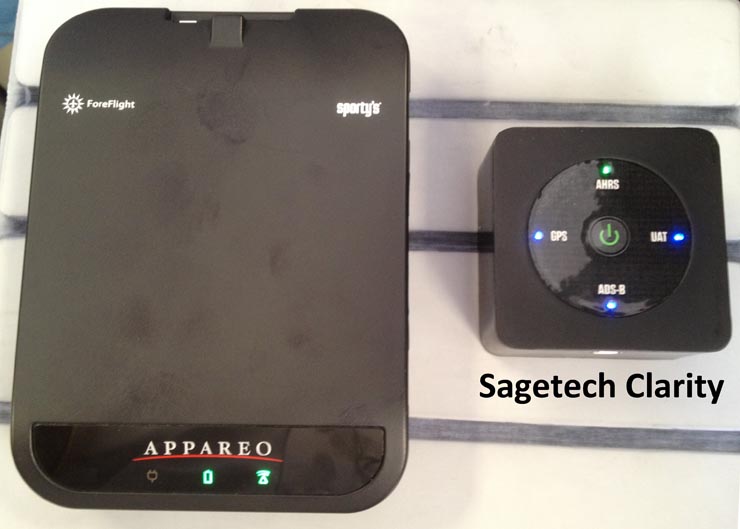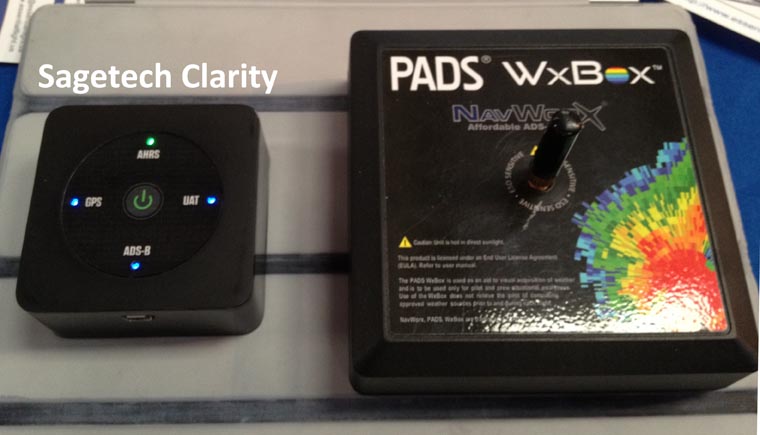I just wanted to let people know the
Sagetech Clairty ADS-B Receiver will offer an alternative to Stratus. Full disclosure, I work at Sagetech, a company that’s been delivering aviation product for the UAS (drone) community for over a decade.
Clarity development is in its final stages, and our website isn’t even up yet (look for it in June). Still I thought I’d post just to let you all know about Clarity, which is comparable to Stratus, except Clarity is much smaller. Here’s a link to a preliminary web page
http://sagetechcorp.com/clarity
The Sagetech Clarity ADS-B Receiver will be offered in three variants:
Clarity Base is pretty much equivalent to the Stratus (978MHz ADS-B Receiver, WAAS GPS, WiFi connection to the iPad), except it a much smaller and convenient unit, and it has longer battery life. Also, whereas the Stratus and other receivers don’t offer TIS-B traffic data, the Clarity will pass along whatever traffic it receives. There are some important subtleties about this though-read on.
Clarity Plus is a dual channel ADS-B receiver, WAAS GPS, WiFi to the iPad 9hrs battery life. Essentially, it adds a 1090MHz TIS-B traffic receiver to the baseline unit.
Clarity SV has all these feature (dual ADS-B receiver, WAAS GPS, WiFi, mondo battery) and also has AHRS for use with Synthetic Vision. WingX EFB software has Synthetic vision already.
Mechanically, Clarity has a simple power button and like Stratus, Clarity’s antennas are all internal to the unit. But Clarity is much smaller and takes up much less dash space. It is also very carefully designed and although it’s not TSO’d, it does meet applicable TSO MOPS (minimum operational requirements).
Pricing will be less than Stratus for the comparable base unit. We haven’t set final pricing so we can’t post that info yet.
Clarity is compatible with windows and android based tablet computers as well as iPad, and won’t be exclusive to one EFB package like Stratus is. We are working with several EFB software providers and expect wide acceptance.
One difference is that Clarity will pass along traffic reports received from FAA ground stations, or received directly from aircraft broadcasting ADS-B out using a 978MHz UAT, or 1090MHz Mode S transponder (Plus and SV dual channel models). Appareo Status and NavWorkPads don’t pass along traffic, Clarity and SkyRadar do. This is important if you’re flying an airplane equipped with an ADS-B out transponder which will be a requirement by the year 2020.
But it is very important to note that traffic isn’t transmitted by default by the FAA ADS-B rebroadcast ground stations so for the most part traffic won’t be very useful unless you’re squawking ADS-B out. Maybe that’s why Stratus just says no to TIS-B traffic data and avoids any confusion. At any rate, Clarity gives you the data it receives without filtering out traffic.
Here are some pics of a Sagetech Clarity prototype I took at Sun n Fun next to the Stratus and Pads receivers:




